Ramallah Archive
Palestine, 2014
series of 19 photographs, 38.5 x 57.7 cm; 66.7 x 100 cm, chromogenic prints
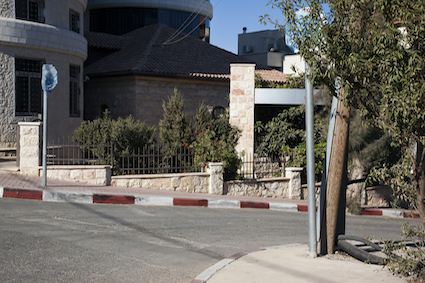 |
Ahlam Shibli, untitled (Ramallah Archive no. 1), Palestine, 2014, chromogenic print, 38.5 x 57.7 cm. Berlin Street, old city, Ramallah, 13 September 2014. On top of a preserved historical building, a new building owned by Mr Hadad, a Palestinian businessman from Amman, houses the offices of his company and a branch of the Jordan Commercial Bank. The establishment of the Palestinian Authority in the West Bank and the Gaza Strip in 1994 initiated a heavy wave of construction. Therefore Ramallah Municipality decided to protect and preserve most of the old houses. Courtesy of the artist, © Ahlam Shibli |
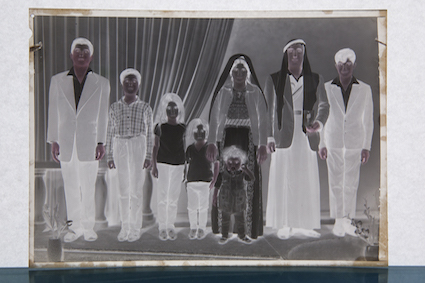 |
Ahlam Shibli, untitled (Ramallah Archive no. 2), Palestine, 2014, chromogenic print, 66.7 x 100 cm. Ramallah Municipality Archive, Ramallah Cultural Palace, Ramallah, 1 July 2014. A photograph of a negative from the late 1950s or early 1960s, produced by Garo Kuftedjian, a studio photographer of Armenian origin, at Studio Venus in Ramallah. The father holds the photograph of another son, who may live in America, considering the emigration patterns of Ramallah residents at that time. Courtesy of the artist, © Ahlam Shibli |
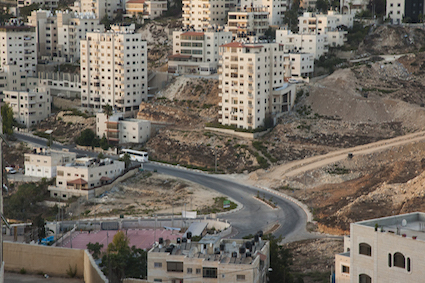 |
Ahlam Shibli, untitled (Ramallah Archive no. 3), Palestine, 2014, chromogenic print, 38.5 x 57.7 cm. Ayn Sam'an neighborhood, Ramallah, 13 September 2014. The arrival of large numbers of Palestinian refugees in the aftermath of al-Nakba, the Palestinian Catastrophe of 1948, caused the population of Ramallah to grow from around 8,000 to 26,000 inhabitants. Immediately after the war of 1967, the population dropped from around 30,000 to less than 25,000 people. In 2014, the population of the city counted around 46,000 residents. The total number of inhabitants of the city and its environs, 80 towns and villages, was approximately 333,000, with an employment rate of 43.8 %. Courtesy of the artist, © Ahlam Shibli |
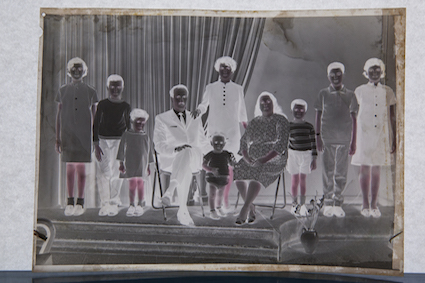 |
Ahlam Shibli, untitled (Ramallah Archive no. 4), Palestine, 2014, chromogenic print, 66.7 x 100 cm. Ramallah Municipality Archive, Ramallah Cultural Palace, Ramallah, 1 July 2014. A photograph from late 1960s or early 1970s showing a negative by Garo Kuftedjian. Arpine Kuftedjian, his wife and assistant, colored and retouched people's skin—ostensibly to improve the contrast, but mainly to lighten dark complexions. Courtesy of the artist, © Ahlam Shibli |
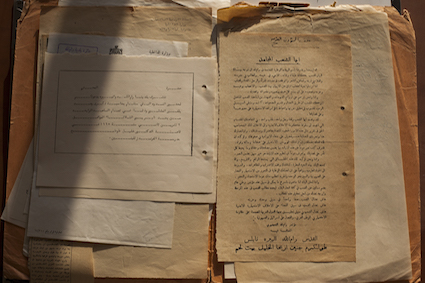 |
Ahlam Shibli, untitled (Ramallah Archive no. 5), Palestine, 2014, chromogenic print, 38.5 x 57.7 cm. Ramallah Municipality Archive, Ramallah Cultural Palace, Ramallah, 11 September 2014. A folder with documents concerning national affairs from 1956 to 1968. The document at the left is an invitation to a symposium on the occasion of the anniversary of the Balfour Declaration in 1965. The document at the right is the announcement of a Ramallah meeting to prepare a conference on the people's support of liberation from colonialism and the elimination of Zionism. Courtesy of the artist, © Ahlam Shibli |
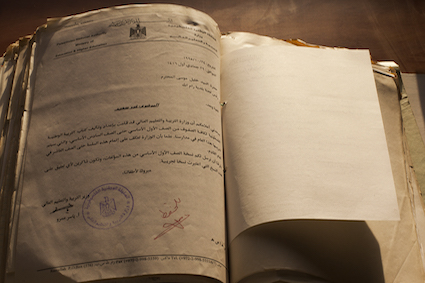 |
Ahlam Shibli, untitled (Ramallah Archive no. 6), Palestine, 2014, chromogenic print, 38.5 x 57.7 cm. Ramallah Municipality Archive, Ramallah Cultural Palace, Ramallah, 11 September 2014. A letter dated 24 October 1995 from the Minister of Education and Higher Education of the Palestinian National Authority to the Mayor of Ramallah announcing good news—a new series of textbooks for all grades of elementary school in the Palestinian national education system—and asking for his comments on the first-grade book. Courtesy of the artist, © Ahlam Shibli |
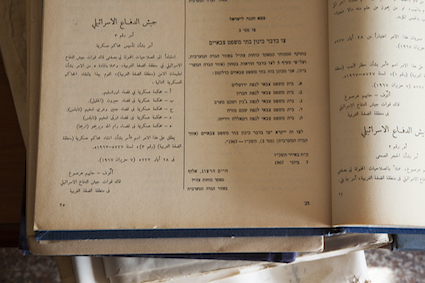 |
Ahlam Shibli, untitled (Ramallah Archive no. 7), Palestine, 2014, chromogenic print, 38.5 x 57.7 cm. Ramallah Municipality Archive, Ramallah Cultural Palace, Ramallah, 6 September 2014. A collection of orders by the Israeli military government and its civilian administration in the West Bank. Shown is the third order announcing the establishment of military courts in the West Bank for the districts of Jerusalem, al-Khalil/Hebron, Jenin and West Nablus, East Nablus, Ramallah, and Jericho. The IDF commander of the West Bank signed the order on 7 June 1967. That same day, the Israeli army entered Jerusalem and ended Jordanian rule. Courtesy of the artist, © Ahlam Shibli |
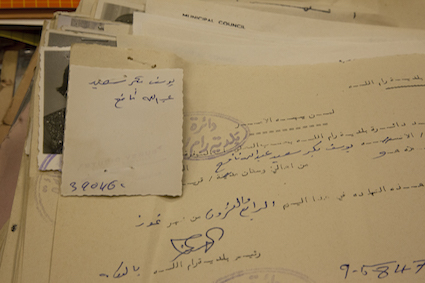 |
Ahlam Shibli, untitled (Ramallah Archive no. 8), Palestine, 2014, chromogenic print, 38.5 x 57.7 cm. Ramallah Municipality Archive, Ramallah Cultural Palace, Ramallah, 6 September 2014. Residential authentication certificate signed by the mayor of Ramallah, dated 1974, with a photo of the person requesting the certificate. The photo bears the stamp of Studio Venus and the serial number used by Garo Kuftedjian to register each photo and negative he made. Courtesy of the artist, © Ahlam Shibli |
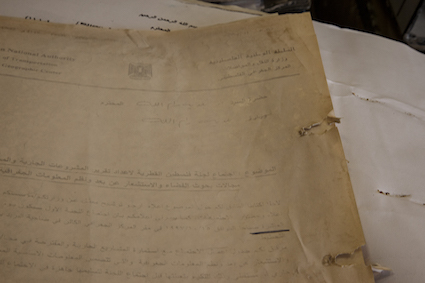 |
Ahlam Shibli, untitled (Ramallah Archive no. 9), Palestine, 2014, chromogenic print, 38.5 x 57.7 cm. Ramallah Municipality Archive, Ramallah Cultural Palace, Ramallah, 6 September 2014. A letter dated 14 October 1997 from the Palestinian Geographical Center at the Ministry of Transportation of the Palestinian National Authority to Ramallah Municipality, inviting a representative to participate in a meeting to prepare a report on projects of space research, remote sensing, and geographic information systems. Courtesy of the artist, © Ahlam Shibli |
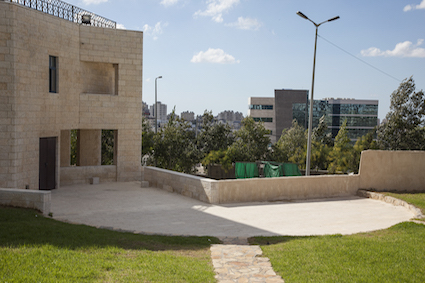 |
Ahlam Shibli, untitled (Ramallah Archive no. 10), Palestine, 2014, chromogenic print, 38.5 x 57.7 cm. Ramallah Cultural Palace, Tokyo Street, Ramallah, 6 September 2014. Established in 2005 by Ramallah Municipality, the United Nations Development Programme (UNDP), and the Government of Japan, the Ramallah Cultural Palace includes one room devoted to the municipal archive, where the negatives of Studio Venus are kept. Visible in the background is the unfinished building of the Palestinian Ministry of Foreign Affairs. Its construction started in 2010. Courtesy of the artist, © Ahlam Shibli |
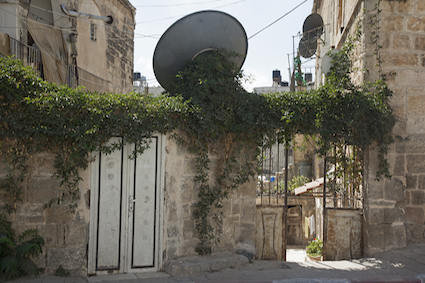 |
Ahlam Shibli, untitled (Ramallah Archive no. 11), Palestine, 2014, chromogenic print, 38.5 x 57.7 cm. Ajlouni compound, Issa Ziadeh Street, Ramallah, 13 September 2014. Most members of the Ajlouni family, one of the original Ramallah families, migrated to the US for employment. Families from the city of al-Dhahiriya settled in their houses in the 1960s. Courtesy of the artist, © Ahlam Shibli |
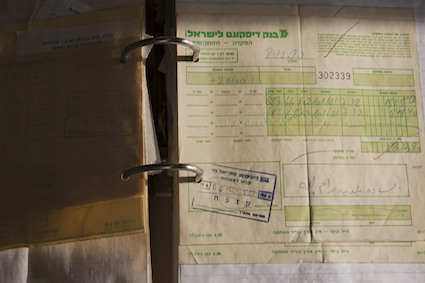 |
Ahlam Shibli, untitled (Ramallah Archive no. 12), Palestine, 2014, chromogenic print, 38.5 x 57.7 cm. Ramallah Municipality Archive, Ramallah Cultural Palace, Ramallah, 6 September 2014. Deposit slip from the Israel Discount Bank, Ramallah Branch, dated 8 December 1987, concerning two checks in favor of Ramallah Municipality. 8 December 1987 also marks the beginning of the First Intifada. Courtesy of the artist, © Ahlam Shibli |
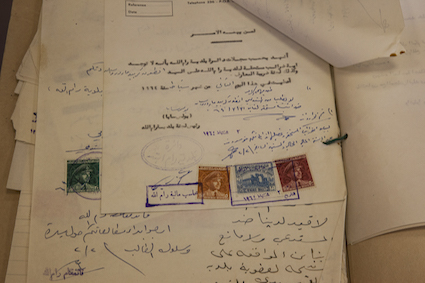 |
Ahlam Shibli, untitled (Ramallah Archive no. 13), Palestine, 2014, chromogenic print, 38.5 x 57.7 cm. Ramallah Municipality Archive, Ramallah Cultural Palace, Ramallah, 6 September 2014. The document on top, dated 2 February 1964, with Jordanian stamps, is a certificate confirming that Mr Anton Mardirosian, of Armenian origin, has paid all his taxes to Ramallah Municipality and the Education Commission. The document below, signed by the Ramallah district governor, states that there are no objections against Mr Mardirosian's candidacy for the Ramallah Municipality Council. Courtesy of the artist, © Ahlam Shibli |
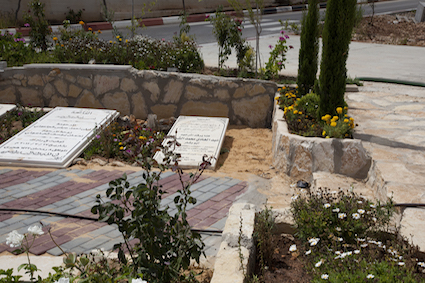 |
Ahlam Shibli, untitled (Ramallah Archive no. 14), Palestine, 2014, chromogenic print, 66.7 x 100 cm. The New Graveyard, Ramallah Industrial Zone, Ramallah, 7 September 2014. The inscription on the gravestone at the right reads: "… the resister, the writer, the intellectual, the human, the clean heart, hand and tongue. Jaffa 9/8/1947 – Ramallah 9/8/ 2012 …". The date and place of the individual's birth and death indicate that he was one of a large number of Palestinian refugees in the aftermath of the 1948 war. Courtesy of the artist, © Ahlam Shibli |
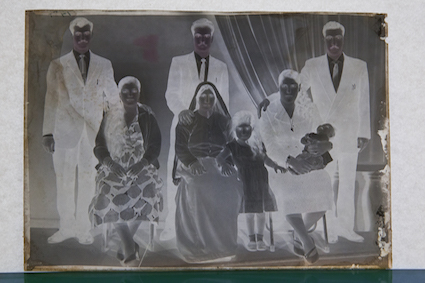 |
Ahlam Shibli, untitled (Ramallah Archive no. 15), Palestine, 2014, chromogenic print, 66.7 x 100 cm. Ramallah Municipality Archive, Ramallah Cultural Palace, Ramallah, 15 June 2014. A photograph of a negative by Garo Kuftedjian. The photographer chose to equip his clients with props, such as a pen in the front pocket, a cigarette in the hand, or a tie. Courtesy of the artist, © Ahlam Shibli |
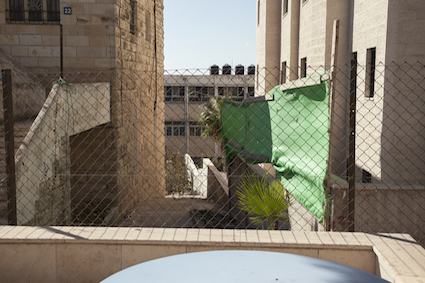 |
Ahlam Shibli, untitled (Ramallah Archive no. 16), Palestine, 2014, chromogenic print, 38.5 x 57.7 cm. Al-Maskoubiyyeh neighborhood, Ramallah, 13 September 2014. The building at the left will be soon destroyed to make room for an apartment building. The new construction at the right surrounds a protected house and contains forty-four apartments. In the middle is the Ramallah Basic Boys School, serving 500 Palestinian refugee children from Ramallah and surroundings. The school belongs to the Education Department West Bank of the United Nations Relief and Works Agency (UNRWA). Courtesy of the artist, © Ahlam Shibli |
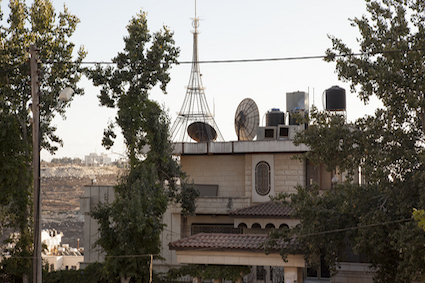 |
Ahlam Shibli, untitled (Ramallah Archive no. 17), Palestine, 2014, chromogenic print, 38.5 x 57.7 cm. Kamal Nasir Street, al-Masaif neighborhood, Ramallah, 13 September 2014. According to locals, the phenomenon of building "Eiffel Towers" on top of houses in Ramallah actually originated in Amman, Jordan, in the 1970s. Two brothers were the first to come up with the idea of building an appealing object to hold the TV antenna on the roof of their villa. They ordered the structure from a local blacksmith. In Jordan and Palestine, an Eiffel Tower indicates the residents' elevated socio-economic status. Courtesy of the artist, © Ahlam Shibli |
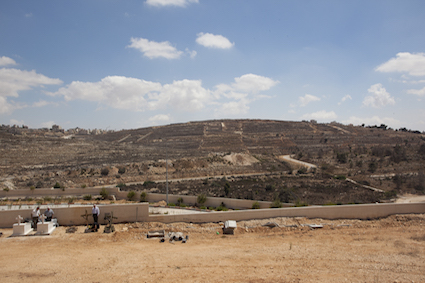 |
Ahlam Shibli, untitled (Ramallah Archive no. 18), Palestine, 2014, chromogenic print, 66.7 x 100 cm. The New Graveyard, Ramallah Industrial Zone, 7 September 2014. The graveyard is divided in two parts: one for Christians, the other for Muslims. The asphalt road behind the graveyard marks the border with Ofer Camp, an Israeli military installation that includes a prison, investigation rooms, and trial facilities used against Palestinian political prisoners. Courtesy of the artist, © Ahlam Shibli |
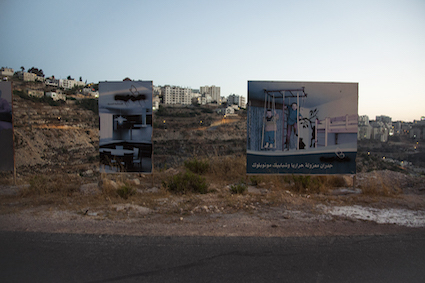 |
Ahlam Shibli, untitled (Ramallah Archive no. 19), Palestine, 2014, chromogenic print, 38.5 x 57.7 cm. Ayn Sam'an and Ayn Musbah neighborhoods, Ramallah, 6 July 2014. The master plan of Ramallah covers approximately 19,000 acres, one third of it reserved for construction areas. The city is home to 20 % of the West Bank housing units. Courtesy of the artist, © Ahlam Shibli |
